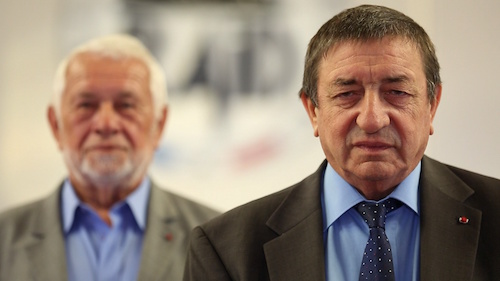
- 58'
- Author : Alexandra Colineau
- 19-11-2017
- Master : 2694
-
Share!
GREAT COPS TELL THEIR STORIES – N°4 | TF1 | Reportages
They are stars of the famous 36 quai des Orfèvres. Ange Mancini was the first head of the RAID, which he created along with Robert Broussard, the man who killed Jacques Mesrine. Richard Marlet was head of the Forensic Identity Section, which he revolutionized.
They delve into their memories to tell us of two major cases that marked their careers. The attack on the Nantes court for Ange Mancini and Robert Broussard. The old lady killer case for Richard Marlet.
Attack on the Nantes courthouse, 1985
December 19 1985. The courtroom in the Nantes assizes courthouse. It’s the beginning of a commonplace trial of two re-offending smalltime robbers, Georges Courtois, 38 and Patrick Thiolet, 24. 10:30, a man bursts into the courtroom holding a grenade with the pin pulled and a magnum. He’s an accomplice of the accused. His name is Karim Kalki. The three of them take the courtroom hostage. 29 people. Their demands are political. In particular, they demand better conditions of detention. They demand that France 3’s TV cameras be present. Everything is filmed. This is the first intervention by the police unit newly created by Robert Broussard: the RAID. At its head is Ange Mancini. His task will be to negotiate with the hostage takers to obtain their surrender and avoid a blood bath.
The old lady killer, 1984-1987
On December 2 1984, an old lady is found brutally murdered at her home in the 18th arrondissement of Paris. It’s the first crime scene for the young local assistant inspector, Richard Marlet. A few days later two identical murders take place in the same neighborhood. It’s the start of a diabolical series that will last for three years. Some thirty old ladies are killed in Paris to be robbed of a few hundred francs. On each occasion, the investigators, led by divisional inspector Bernard Laithier, pick up the same fingerprints. But the prints don’t correspond to any criminal already known to 36 quai des Orfèvres. At the time there is no centralized computer criminal record system. For three years, investigators will compare tens of thousands of prints with the naked eye, with no success. In fact, the serial killer was right under their noses. His name is Thierry Paulin. This case will expose the huge lag in French forensic identification techniques and will speed up its modernization.
As if in a crime novel, managing the suspense, we relate how the investigations, the stakeouts and the searches unfolded. We build our story on the testimonies of these stars of number 36. We turn them into images with footage from both police and personal archives and by reconstructing the key moments of the investigations. Beyond the relating of the facts, we relive the way these two great cops experienced these cases. Their problems, the euphoria of important discoveries, but also their fears and their regrets.
